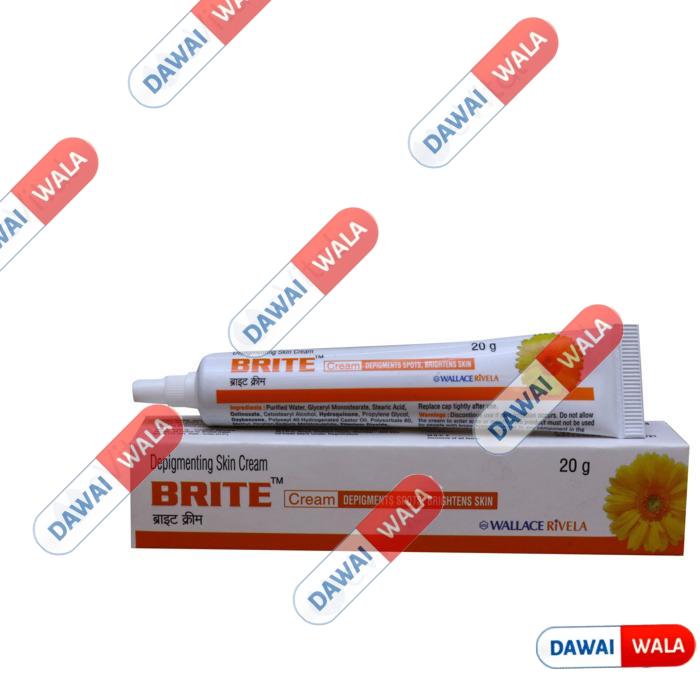

Hydroquinone (4% w/w)
Brite Cream is for external use only. You should use it in the dose and duration as advised by your doctor. You must wash your hands thoroughly before and after applying this medicine. This medicine should be used regularly to get the most benefit from it. Do not use more than you need as some side effects may be increased.Brite Cream has a few potential side effects but not everyone will get them. These may include dry skin, itching, skin burn, skin peeling, and skin redness. Serious allergic reaction to this drug is rare but let your doctor know if you’re bothered by side effects or they do not go away. Make sure you read the instructions that come with your medicine. Avoid contact with eyes. In case of accidental contact, you should rinse your eyes thoroughly with water.You can start applying Brite Cream to a small portion of unbroken skin or near the pigmented area for a period of several days for checking an allergic reaction. You should discontinue it if itching, excessive inflammation, or swelling occurs. Pregnant women should consult their doctor before taking this medicine. If no improvement is seen after two months of treatment, the use of this product should be discontinued.
Most side effects do not require any medical attention and disappear as your body adjusts to the medicine. Consult your doctor if they persist or if you’re worried about themCommon side effects of Brite
20 gm Cream
Image shown is a representation and may slightly vary from the actual product. Every effort is made to maintain accuracy of all information displayed.
This medicine is for external use only. Use it in the dose and duration as advised by your doctor. Check the label for directions before use. Clean and dry the affected area and apply the cream. Wash your hands after applying, unless hands are the affected area.
Brite Cream is a skin lightening medication.
Related Warnings
No interaction found/established
Brite Cream may be unsafe to use during pregnancy. Although there are limited studies in humans, animal studies have shown harmful effects on the developing baby. Your doctor will weigh the benefits and any potential risks before prescribing it to you. Please consult your doctor.
Brite Cream is probably safe to use during breastfeeding. Limited human data suggests that the drug does not represent any significant risk to the baby.
No interaction found/established
No interaction found/established
No interaction found/established
Brite Cream should be used exactly as directed by your doctor. You should apply it away from the eyes, nose, corners of the mouth, or open wounds because these areas are more prone to irritation. If local irritation persists or becomes severe, discontinue Brite Cream and consult your doctor. Excessive use of the medication may cause redness, peeling, or discomfort.
No, it does not lighten the skin permanently. If melasma occurs on discontinuing Brite Cream, talk to your doctor regarding the maintenance treatment of melasma.
You should avoid exposure to sunlight, use sunscreen, and wear protective clothing after treatment with Brite Cream cream. Even a small amount of sunlight can worsen melasma. Females should avoid the use of birth control methods that contain hormones such as oral birth control pills as these methods can worsen your melasma. Talk to your doctor about other birth control options. Be careful as hot and cold weather may irritate the skin treated with Brite Cream.
Brite Cream should be applied once a day, before bedtime. The area to be treated should be thoroughly washed with water. Apply a thin layer of Brite Cream to the affected skin areas. Include about half an inch of normal skin surrounding the affected area. Gently rub Brite Cream evenly into your skin. Do not apply it near the corners of your mouth, nose, eyes, or open wounds.
Brite Cream is applied generally at bedtime. You may use moisturizers and cosmetics during the day when you are not using Brite Cream.
Brite Cream may cause blue-black darkening of the skin. If this occurs, you should immediately stop Brite Cream and consult your doctor. In some cases, it may also cause mild to moderate irritation such as skin reddening, peeling, mild burning sensation, dryness, and itching at the site of application. But this is usually tolerable and may disappear with time.